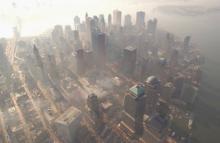SAN FRANCISCO – More than a decade after the event, asthma, chronic obstructive pulmonary disease, and other respiratory symptoms are more common among lower Manhattan residents whose homes were covered with dust from the 9/11 attacks.
"All of these [respiratory] symptoms and diseases have elevated rates in this population," said Dr. Vinicius Antao of the Centers for Disease Control and Prevention’s Agency for Toxic Substances and Disease Registry, who led an investigation into the issue.
"We found that after controlling for variables" such as age, sex, and smoking, "they are at least 50% more likely to report these [problems than are] those who didn’t have any damage done to their homes," he said.
People who cleaned up the dust with a wet mop, instead of a broom and dustpan, have fewer respiratory problems today. Wet mopping probably kept dust particles from resuspending.
"Now we know" that even brief catastrophic dust exposure can cause "symptoms for a long time," Dr. Antao said.
That finding "will inform public health decision making in terms of emergency preparedness. We need to evacuate a population in a circumstance like this," he said.
His team linked the self-reported health status of 6,463 people in the World Trade Center Health Registry, a longitudinal project that tracks outcomes for 9/11 survivors with the amount of damage they said the attacks did to their homes. The respondents all lived below Canal Street in lower Manhattan on Sept. 11, 2001. The research is ongoing, but the data analyzed were from 2003 to 2007.
Dr. Antao and his colleagues excluded people who helped with the cleanup at ground zero, and controlled for people caught up in the dust cloud that billowed through Manhattan after the towers came down. The dust was a mixture of fine powdered concrete products, metals, and minerals, including asbestos, among other things.
People who said there was a heavy dust layer in their home – so much dust, for instance, that they couldn’t read a newspaper that was covered with it – were more likely than were those with no dust in their homes to report shortness of breath (odds ratio, 1.74; 95% confidence interval, 1.45-2.10), wheezing (OR, 1.68; 95% CI, 1.36-2.08), chronic cough (OR, 1.58; 95% CI, 1.23-2.01), upper respiratory symptoms (OR, 1.37; 95% CI, 1.17-1.60), asthma (OR, 1.30; 95% CI, 1.01-1.70), and COPD (OR, 1.37; 95% CI, 1.02-1.84).
Their rates of asthma and COPD are "slightly higher" than rates in the general population, Dr. Antao said.
His team also found a significant, but less pervasive, association with respiratory symptoms in people who said the shock wave from the towers’ collapse blew out their windows or damaged their furniture.
Dr. Antao said he doesn’t think recall bias is at work, especially since years have passed since the 9/11 attacks, meaning that the shock of the event has worn off to some extent and is less likely to color survivors’ perceptions of its effects on their health. "We’ve looked at different aspects of that, and most of the results that we have indicate that these data are real," he said.
Dr. Antao said he has no relevant financial disclosures.



